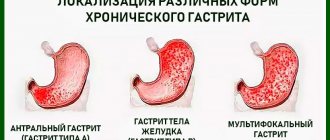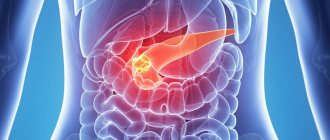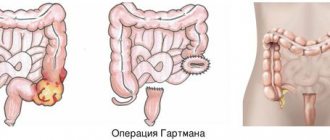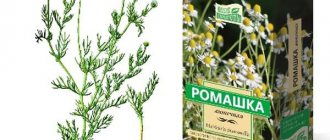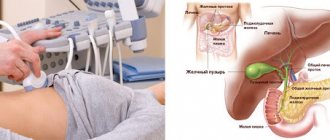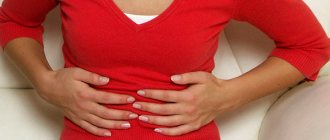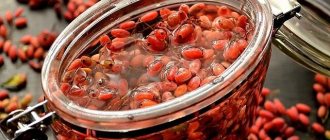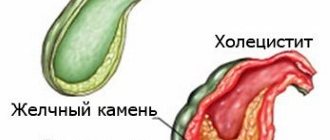Inflammation of the gallbladder occurs as a complication of cholelithiasis; the acalculous form of the disease is less common. 40% of patients experience dangerous complications: pancreatitis, gallstone perforation, peritonitis, obstructive jaundice. Chronic inflammation often causes cancer. The answer to the question of how to treat inflammation of the gallbladder (cholecystitis) depends on the course of the disease, concomitant pathologies, the patient’s age and the presence of contraindications. The main methods of choice are drug and surgical treatment.
Danger of disease
There are calculous and non-calculous cholecystitis. The first form is a complication of cholelithiasis (GSD). The cause of the pathology is stones. The formations may not bother a person for a long time, but at any moment the stones begin to migrate to the area of the head of the gallbladder and into the ducts. Damage to the mucous membrane, impaired outflow of bile, increased pressure in the organ lead to the development of an inflammatory process. Gallstone disease and calculous cholecystitis are more common in women. Reasons include hormonal imbalances, taking oral contraceptives, pregnancy, and emotionality. Obesity, rapid weight loss, strict diets and fasting also contribute to the development of cholelithiasis and impaired bladder motility. The physiological cause of the development of cholelithiasis is a change in the composition of bile, impaired motility of the gallbladder and duct sphincters. The acalculous form of cholecystitis is more dangerous and more often develops into complications. The causes of cholecystitis can be associated with trauma, burns, childbirth, surgery, and infection. Patients on parenteral (artificial) nutrition and people practicing fasting are at risk. Non-calculous cholecystitis is more common in men and is infectious in nature. The disease is more dangerous than the inflammation associated with cholelithiasis. Acalculous cholecystitis is more difficult to diagnose, quickly develops into complications and has a high mortality rate.
| Form of inflammation | Characteristic sign |
| Catarrhal | Inflammation of the mucous membrane of an organ |
| Phlegmonous | Purulent inflammation |
| Gangrenous | Death of gall tissue |
| Emphysematous | Inflammation with gas formation |
Catarrhal is the least dangerous. In other cases, there is a high risk of perforation of the bladder with the outflow of inflamed fluid into the abdominal area. The main diagnostic methods are ultrasound, blood tests, and gastroscopy to exclude peptic ulcers. Based on the results of an ultrasound examination, stones are identified. Cholecystitis is indicated by uneven thickening of the walls of an organ, the presence of liquid or gases, enlargement of the organ or its shrinkage. Cholecystitis can be acute and chronic. The first form is characterized by a clear manifestation of signs of inflammation: severe pain in the right hypochondrium, temperature up to 38.5, nausea and vomiting.
Chronic cholecystitis often occurs after acute cholecystitis and is characterized by moderate symptoms. A person may complain of heaviness in the right side, digestive problems, and intolerance to fatty foods. Erased symptoms of even acute inflammation are typical for older people and patients with diabetes. The mild course of the disease is deceptive. In the long term, the disease can cause cancer. Treatment of cholecystitis at home without medical supervision is fraught with life-threatening complications. One of the popular methods of self-medication is cleansing the liver when heaviness in the side appears. People use choleretic drugs and vegetable oil. However, in case of chronic calculous cholecystitis, such a measure will increase the risk of complications. At the first signs of cholecystitis, you must undergo an ultrasound and agree on a treatment regimen with your doctor.
Risk factors for developing noncalculous cholecystitis:
- stagnation of bile (it is facilitated by abnormalities and decreased tone of the gallbladder, fasting, non-compliance with diet, parenteral nutrition);
- sedentary lifestyle;
- pregnancy;
- prolapse of abdominal organs;
- injuries;
- stress;
- chronic inflammatory diseases of the gastrointestinal tract;
- sickle cell anemia;
- diabetes;
- vasculitis (with systemic lupus erythematosus, polyarteritis nodosa).
All of these disorders cause a decrease in the motor function of the gallbladder, stagnation of bile and lead to aseptic inflammation of the gallbladder wall. Then a pathogenic or opportunistic microflora joins in and the inflammation becomes infectious.
Diet therapy
Diet and nutrition directly affect the functioning of the biliary system. For diseases of the gallbladder and liver, therapeutic diet No. 5 is prescribed. The basic rules of such nutrition are fractionalization and rationality. The energy value of the diet must meet the individual needs of the body. The difference between therapeutic nutrition is the absence of choleretic products and difficult-to-digest foods. Fats are not completely excluded; it is preferable to consume them in the form of vegetable oils and butter. Simple carbohydrates are eliminated and the amount of fiber increases.
It is important to eat every two and a half hours and before bed. Hunger for more than 4 hours negatively affects the condition of the gallbladder. Portion sizes must correspond to the physiological needs of a person. It is important to avoid overeating. Errors in nutrition during cholelithiasis and chronic cholecystitis can cause exacerbation.
- fatty meat and fish, offal, rich broths;
- alcohol;
- strong coffee and tea, carbonated drinks, undiluted sour juices;
- vegetables with a high content of oxalic acid and essential oils: fresh garlic and onions, radishes, turnips, sorrel, spinach, white cabbage;
- sour fruits, berries;
- rye bread, baked goods, desserts with cream;
- chocolate, cocoa, snacks, nuts, mushrooms;
- legumes, corn, millet cereals.
Cooking methods are limited: fried and sautéed foods are excluded, preference is given to boiled and steamed food. If cholelithiasis occurs without symptoms, stewing and baking can be allowed.
During the period of exacerbation of cholecystitis, the diet becomes more strict. During an attack, the patient is advised to fast for one to two days. After stopping the attack, diet No. 5a is prescribed. Food is crushed and ground; porridges and vegetarian pureed soups are preferred. Dishes are served warm; cold and hot foods, which can cause spasm of the sphincter of Oddi, are excluded. In addition to the prohibitions of diet No. 5, fresh vegetables and fruits are excluded from the diet. Only boiling and steaming are allowed. Salt and sugar are limited as much as possible. Two weeks after the attack subsides, the patient can switch to a basic diet.
Mineral water therapy
Drinking treatment for cholecystitis has a beneficial effect on the functioning of the liver, effectively improves the composition of bile, helps normalize gallbladder motility, and cleanses the biliary system of inflammatory fluid. You can be treated in this way in a sanatorium and at home. Waters of low and medium mineralization containing magnesium, sodium, chlorine ions, and organic substances are useful. The choice depends on the state of the digestive system. For cholecystitis, it is recommended to take warm and hot water up to 45 degrees.
Typically, treatment begins with a serving of 50–100 ml three times a day 1–1.5 hours before meals. During the first week, the single dose is gradually increased to 250 ml. The course of therapy is 35–40 days. The break between treatment with mineral waters should be long, at least 4 months. In case of impaired motility of the gallbladder and stagnation of bile, drinking tubes quickly help. The patient drinks a glass of warm mineral water in the morning on an empty stomach, then performs a set of physical therapy exercises. After this, he drinks another 200 ml of water and lies down with a heating pad on his right side. When the procedure is carried out correctly, pain, nausea, and bitterness in the mouth quickly decrease. At home, tubing is carried out 1–3 times a month, under the supervision of doctors – 1–2 times a week. This treatment is contraindicated in case of cholelithiasis. In the calculous form of cholecystitis, tubages and mineral waters that have a pronounced choleretic effect or with a high level of mineralization are not recommended. After cholecystectomy, you can be treated in this way after 3-4 months at home, but under the supervision of a doctor.
Drug treatment
An attack of acute cholecystitis requires urgent hospitalization in the surgical department. Based on the examination results, doctors decide whether a cholecystectomy is necessary. The operation can be performed as an emergency, after 2-3 days or after a few weeks, when the patient has undergone drug therapy and a full examination. Drug therapy is aimed at reducing the severity of cholecystitis and symptomatic treatment. The following groups of drugs are used:
- antibiotics, the course of treatment is 7–10 days, the choice of drug depends on the results of culture of the gallbladder secretion, the ability of the drug to penetrate the bile and accumulate in it is taken into account;
- anti-inflammatory and analgesic drugs, antispasmodics.
In 85% of cases, an attack of acute cholecystitis resolves without surgical intervention. However, 30% relapse within the first three months. The nature of the disease depends on the composition, size and shape of the stones. Small stones less than 5 mm in diameter can pass through the bile ducts into the intestines. More often, the bile ducts are blocked by stones, which causes exacerbation of cholelithiasis. Large stones damage the head of the gallbladder and can lead to bedsores and damage to the mucous membrane of the organ. In rare cases, stones move into the duodenum and can cause intestinal obstruction.
L.P. Kovaleva in the article “Modern aspects of the chronic form of cholecystitis” raises the problem of the use of antibiotics in the acute form of cholecystitis. Prescription of drugs should be after obtaining the results of bile culture and identifying an infection. Taking antibiotics and painkillers at the beginning of an attack can blur the picture of symptoms of dangerous complications.
There is no consensus among doctors on how to properly treat inflammation of the gall bladder. Thus, a controversial issue is the prescription of choleretic and cholekinetic drugs. Medicines are aimed at enhancing the motility of the biliary tract and more intense bile production. These are the basic means in the treatment of chronic cholecystitis.
As part of the treatment of the disease during remission, the doctor may prescribe a course of tranquilizers. Medicines effectively restore the nervous mechanisms regulating the gallbladder and ducts. All patients suffering from chronic cholecystitis experience disturbances in the emotional sphere: increased anxiety, sleep disturbances, and a tendency to depression. These symptoms are especially pronounced in women. Negative emotions and stress provoke an exacerbation of the disease. During the period of remission, you can be treated with herbal medicine methods, which are aimed at improving the secretory functions of the liver, normalizing the motility of the biliary tract and relieving inflammation. Therapy can be carried out at home after consulting a doctor. On an outpatient basis, physiotherapy is possible, which has an analgesic and anti-inflammatory effect.
How to prevent relapses?
Patients must learn to independently assess their condition. For example, if you have acute pain, you should not exercise. In other cases, walking, morning exercises, and swimming are indicated.
Following the rules of dietary nutrition will help replace medications. Patients know what disorders cause increased pain, so they should not bring their condition to a severe form of the disease. A consistent regimen without overeating during the holidays helps maintain health and good mood.
Surgical treatment
Chronic calculous cholecystitis is an indication for planned removal of the gallbladder (cholecystectomy). If complications of cholelithiasis develop, emergency surgery may be performed. The standard treatment is laparoscopy. The operation is performed through punctures in the abdominal area. This method has a lower risk of complications and a shorter recovery period. The patient is left with subtle marks that compare favorably with a scar after traditional abdominal surgery.
Laparoscopy lasts from one and a half to two hours. Already on the second or third day the patient is discharged. The postoperative period is quite easy and may be accompanied by moderate pain. Complications occur in 0.1% of cases. They are usually associated with technical errors or incorrect diagnosis. Cholecystectomy can completely cure cholecystitis in 60% of patients.
- chronic calculous cholecystitis;
- recurrent cases of hepatic colic;
- the gallbladder is more than half filled with stones;
- obstructive jaundice.
The operation allows you to avoid dangerous complications: peritonitis, acute pancreatitis, bladder perforation, gangrene, oncology.
Classification
Acute non-calculous cholecystitis has no subtypes and is characterized by the most striking clinical signs of the disease. Chronic acalculous lesions of the gallbladder last a long time and are divided into stages: a period of exacerbation, alternating subsidence and exacerbation, stable or unstable remission.
Depending on the frequency of exacerbations, the course is distinguished:
- monotonous (constant);
- intermittent.
According to the degree of spread of inflammation from the gallbladder, two forms are suggested: uncomplicated, complicated - the spread of inflammation to neighboring tissues and organs. The manifestation of clinical symptoms allows us to identify a typical form and an atypical course.
Percutaneous cholecystostomy
In addition to laparoscopy, there are alternative minimally invasive operations that allow you to preserve the existing bladder. Percutaneous cholecystostomy is indicated for patients with contraindications to laparoscopy. Sometimes the procedure becomes preparation for organ removal. Under ultrasound guidance, the doctor inserts a thin catheter into the bladder through a puncture in the abdomen. Inflammatory fluid, bile and pus are pumped out of the organ. The catheter allows you to deliver medications directly to the area of inflammation. In emergency cases, the procedure avoids emergency surgery and gives time to prepare for a planned cholecystectomy.
Cholecystostomy can be used as the main method of treatment in patients with contraindications to surgery and people who refuse surgery. The catheter is left in place for the entire duration of treatment. In combination with drug therapy, the method allows you to completely cure cholecystitis.

